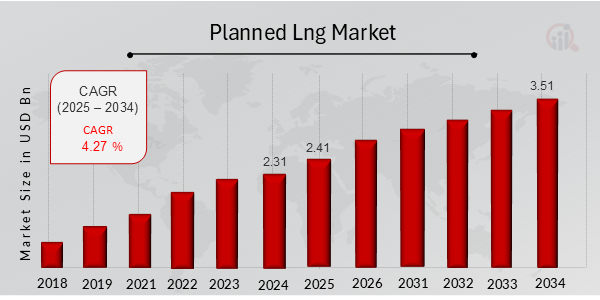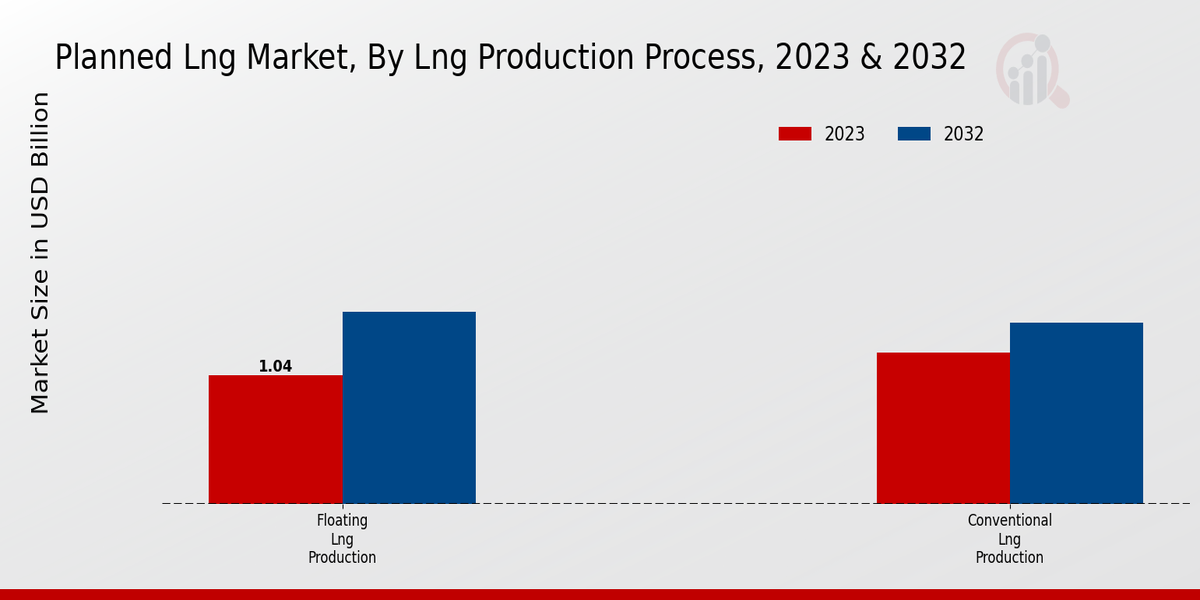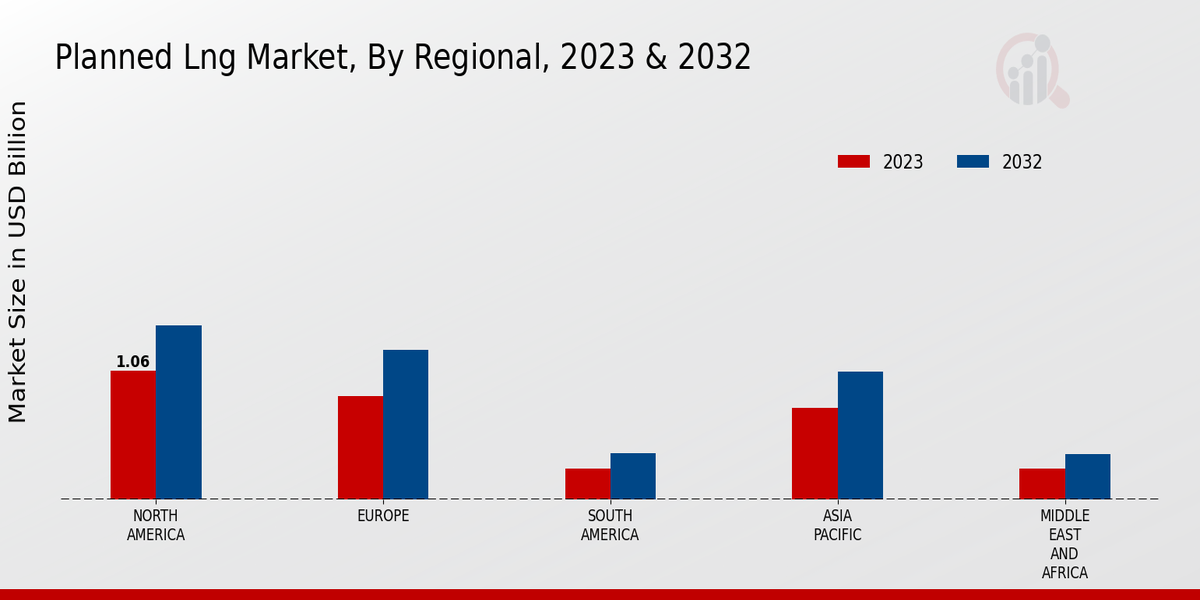Planned LNG Market Overview
As per MRFR analysis, the Planned Lng Market Size was estimated at 2.31 (USD Billion) in 2024. The Planned Lng Market Industry is expected to grow from 2.41 (USD Billion) in 2025 to 3.51 (USD Billion) till 2034, at a CAGR (growth rate) is expected to be around 4.27% during the forecast period (2025 - 2034)
Key Planned Lng Market Trends Highlighted
LNG is expected to continue to be a low-carbon energy source in the long term. Demand for LNG is increasing in both developed and developing countries due to its environmental benefits, versatility, and affordability. Asia-Pacific is the largest LNG market, followed by Europe and North America. Key market drivers include rising demand for cleaner energy sources, government support for LNG infrastructure, and increasing demand from emerging economies. Opportunities for growth include developing new LNG supply sources, expanding LNG infrastructure, and increasing LNG consumption in developing countries. The LNG market is expected to experience steady growth in the coming years. The key trends expected to shape the future of the LNG market include the adoption of LNG as a clean energy source, the development of new LNG production facilities, and the growth of the LNG trade. These trends are expected to create opportunities for companies involved in the LNG supply chain, including LNG producers, LNG traders, and LNG shipping companies.

Source Primary Research, Secondary Research, MRFR Database and Analyst Review
Planned Lng Market Drivers
Growing Demand for Natural Gas
Natural gas is a clean-burning fossil fuel that is becoming increasingly popular around the world. It is used to generate electricity, heat homes and businesses, and power vehicles. The demand for natural gas is expected to continue to grow in the coming years, driven by factors such as population growth, urbanization, and the increasing use of natural gas in power generation. This growth in demand is expected to drive the growth of the Planned Lng Market Industry.
Government Regulations and Policies
Government regulations and policies are also playing a role in the growth of the Planned Lng Market Industry. Many governments are implementing policies to reduce greenhouse gas emissions and promote the use of renewable energy sources. These policies are creating a favorable environment for the development of LNG projects. Governments are providing financial incentives, such as tax breaks and subsidies, to encourage the development of LNG infrastructure.They are also streamlining the regulatory process for LNG projects to reduce the time and cost of development.
Technological Advancements
Technological advancements are also driving the growth of the Planned Lng Market Industry. The development of new technologies, such as floating LNG (FLNG) liquefaction units, is making it possible to develop LNG projects in remote locations. These technologies are also reducing the cost of LNG production, making it more competitive with other fuels.
Planned Lng Market Segment Insights
Planned Lng Market LNG Production Process Insights
The LNG production process involves several stages, from gas extraction to liquefaction and storage. The two main types of LNG production processes are Conventional LNG Production and Floating LNG Production. Conventional LNG Production is the traditional method of producing LNG. It involves extracting natural gas from underground reservoirs, transporting it via pipelines to onshore liquefaction plants, and then storing and shipping the LNG to consumers. Onshore liquefaction plants require significant infrastructure and investment, making them more suitable for large-scale LNG projects.Floating LNG Production (FLNG) is an innovative approach to LNG production that has gained traction in recent years. FLNG involves using floating production, storage, and offloading (FPSO) vessels to extract, liquefy, and store LNG offshore. FLNG vessels are typically deployed in remote areas or near offshore gas fields, allowing for the exploitation of gas reserves that would otherwise be inaccessible. The increasing demand for cleaner energy sources, coupled with the growing adoption of LNG as a transportation fuel, is driving the growth of the Planned Lng Market.Conventional LNG Production is expected to continue as the dominant process, accounting for a major share of the market revenue. However, Floating LNG Production is gaining popularity due to its cost-effectiveness and flexibility, and is expected to witness significant growth in the coming years.

Source Primary Research, Secondary Research, MRFR Database and Analyst Review
Planned Lng Market End-Use Sector Insights
The end-use sector segmentation of the Planned Lng Market offers valuable insights into the diverse applications of Planned Lng across various industries. The 'Power Generation' segment holds a significant share of the market, driven by the growing demand for reliable and efficient electricity generation. The 'Industrial' segment is also a key contributor, as Planned Lng is used as a feedstock in various industrial processes. The 'Transportation' segment is expected to witness steady growth due to the increasing adoption of Planned Lng as a cleaner fuel source for vehicles. The 'Residential and Commercial' segment holds a substantial share, with Planned Lng being used for heating and cooking purposes.
Planned Lng Market LNG Sourcing Insights
LNG Sourcing is a crucial segment in the Planned Lng Market, influencing the availability and cost of LNG for various end-use sectors. In 2023, the LNG sourcing market was valued at approximately USD 2.13 billion, and it is projected to reach USD 3.1 billion by 2032, exhibiting a CAGR of 4.27%. Pipeline gas remains a dominant LNG sourcing option, accounting for a significant share of the market. The extensive pipeline network provides reliable and cost-effective transportation of LNG to major demand centers. LNG imports play a vital role in meeting the growing demand for LNG, particularly in regions with limited domestic production.The LNG trade is expected to continue expanding, driven by increasing demand from emerging economies in Asia and Europe. Domestic production of LNG is gaining traction as countries seek to enhance energy security and reduce reliance on imports. The development of new LNG production facilities and the expansion of existing ones are expected to contribute to the growth of this segment. The LNG sourcing market is influenced by various factors, including geopolitical dynamics, technological advancements, and environmental regulations. Governments and industry players are actively involved in shaping the regulatory landscape and promoting sustainable LNG sourcing practices.
Planned Lng Market LNG Storage Type Insights
The LNG Storage Type segment of the Planned Lng Market is categorized into Underground Storage, Above-Ground Storage, and Floating Storage. Underground Storage dominated the market in 2023, accounting for $1.23 billion in revenue. Underground Storage is expected to maintain its dominance throughout the forecast period due to factors like cost-effectiveness, enhanced safety, and minimal environmental impact. Above-Ground Storage is anticipated to witness steady growth owing to its lower construction costs and shorter construction time. Floating Storage is likely to gain traction, driven by its flexibility and mobility, enabling it to be deployed in areas with limited onshore infrastructure.
Planned Lng Market LNG Terminal Type Insights
The Planned Lng Market is segmented by LNG Terminal Type into Import Terminals, Export Terminals, and Regasification Terminals. Among these segments, the Import Terminals segment is expected to hold the largest market share in 2023, owing to the increasing demand for LNG imports in emerging economies. The Export Terminals segment is projected to exhibit the highest CAGR during the forecast period, driven by the rising production of LNG in regions such as the United States and Australia. The Regasification Terminals segment is anticipated to witness steady growth, supported by the expansion of LNG infrastructure in developing countries.The Planned Lng Market revenue for Import Terminals is projected to reach USD 1.2 billion by 2024, while the Export Terminals segment is estimated to generate revenue of USD 0.6 billion by 2024. The Regasification Terminals segment is expected to contribute USD 0.3 billion to the overall market revenue by 2024.
Planned Lng Market Regional Insights
Regionally, North America is expected to be the largest market for Planned Lng Market, accounting for a significant share of the market in 2023. The region is home to several major LNG producers and consumers and is expected to continue to be a key driver of growth for the Planned Lng Market. Europe is also a major market for Planned Lng Market, with a number of countries in the region having set ambitious targets for reducing greenhouse gas emissions. The APAC region is expected to be the fastest-growing market for Planned Lng Market over the forecast period, driven by increasing demand for LNG in countries such as China, India, and South Korea.South America and MEA are also expected to experience steady growth in the Planned Lng Market, as countries in these regions look to LNG as a cleaner alternative to traditional fossil fuels.

Source Primary Research, Secondary Research, MRFR Database and Analyst Review
Planned Lng Market Key Players And Competitive Insights
Major players in Planned Lng Market are investing heavily in research and development to develop new products and technologies. The industry is characterized by the presence of a few large players that account for a significant share of the market. The competitive landscape is expected to remain fragmented in the coming years, with new entrants and existing players competing for market share. Leading Planned Lng Market players are focusing on expanding their geographical presence and product portfolio to cater to the growing demand for planned LNG. Strategic partnerships and collaborations are expected to be a key trend in the Planned Lng Market industry as companies seek to strengthen their position in the market. A leading company in the Planned Lng Market is BP.
The company is headquartered in London, United Kingdom, and has a presence. BP is engaged in the exploration, development, production, and transportation of oil and gas. The company has a strong focus on sustainability and is committed to reducing its carbon emissions. BP is investing heavily in renewable energy and is developing new technologies to reduce the environmental impact of its operations. The company has a strong track record of innovation and is well-positioned to benefit from the growing demand for planned LNG.A major competitor in the Planned Lng Market is Royal Dutch Shell. The company is headquartered in The Hague, Netherlands, and has a presence. Shell is engaged in the exploration, development, production, and transportation of oil and gas. The company also has a strong presence in the renewable energy sector. Shell is investing heavily in new technologies to reduce its carbon emissions and is committed to becoming a net-zero emissions company by 2050. The company has a strong track record of innovation and is well-positioned to benefit from the growing demand for planned LNG.
Key Companies in the Planned Lng Market Include
- Woodside Energy
- Shell
- NextDecade
- Rosneft
- ExxonMobil
- QatarEnergy
- Chevron
- Gazprom
- TotalEnergies
- Petronas
- Cheniere Energy
- EQT
- Petrobras
- Sempra Energyn
- ConocoPhillips
Planned Lng Market Industry Developments
The Planned Lng Market is anticipated to reach USD 2.31 billion in 2024 and is projected to grow at a CAGR of 4.27% from 2025 to 2034, reaching USD 3.51 billion by 2034. Rising demand for LNG as a cleaner alternative to traditional fossil fuels, particularly in the power generation and transportation sectors, is driving market growth. Government initiatives promoting LNG adoption, technological advancements in LNG production and transportation, and increasing investments in LNG infrastructure are further fueling market expansion. Key industry participants include Shell, BP, ExxonMobil, Chevron, and TotalEnergies, among others. Recent developments include the commissioning of new LNG terminals and pipelines, strategic partnerships between industry players, and ongoing research and development efforts to enhance LNG production efficiency and reduce environmental impact.
Planned Lng Market Segmentation Insights
- Planned Lng Market LNG Production Process Outlook
- Conventional LNG Production
- Floating LNG Production
- Planned Lng Market End-Use Sector Outlook
- Power Generation
- Industrial
- Transportation
- Residential and Commercial
- Planned Lng Market LNG Sourcing Outlook
- Pipeline Gas
- LNG Imports
- Domestic Production
- Planned Lng Market LNG Storage Type Outlook
- Underground Storage
- Above-Ground Storage
- Floating Storage
- Planned Lng Market LNG Terminal Type Outlook
- Import Terminals
- Export Terminals
- Regasification Terminals
- Planned Lng Market Regional Outlook
- North America
- Europe
- South America
- Asia Pacific
- Middle East and Africa
| Report Attribute/Metric |
Details |
|
Market Size 2024
|
2.31 (USD Billion)
|
|
Market Size 2025
|
2.41 (USD Billion)
|
|
Market Size 2034
|
3.51 (USD Billion)
|
|
Compound Annual Growth Rate (CAGR)
|
4.27% (2025 - 2034)
|
|
Report Coverage
|
Revenue Forecast, Competitive Landscape, Growth Factors, and Trends
|
|
Base Year
|
2024
|
|
Market Forecast Period
|
2025 - 2034
|
|
Historical Data
|
2019 - 2023
|
| Market Forecast Units |
USD Billion |
| Key Companies Profiled |
Woodside Energy, Shell, NextDecade, Rosneft, ExxonMobil, QatarEnergy, Chevron, Gazprom, TotalEnergies, Petronas, Cheniere Energy, EQT, Petrobras, Sempra Energyn, ConocoPhillips |
| Segments Covered |
LNG Production Process, End-Use Sector, LNG Sourcing, LNG Storage Type, LNG Terminal Type, Regional |
| Key Market Opportunities |
LNG as a cleaner fuel Rising energy demand in emerging economies Technological advancements Growing LNG infrastructure Favorable government policies |
| Key Market Dynamics |
Increased LNG demand Growing infrastructure investments Government policies and regulations Technological advancements Competitive landscape |
| Countries Covered |
North America, Europe, APAC, South America, MEA |
Frequently Asked Questions (FAQ) :
The Planned Lng Market is expected to reach USD 3.1 billion by 2032, exhibiting a CAGR of 4.27% between 2024 and 2032.
Asia-Pacific is anticipated to dominate the Planned Lng Market owing to the rising demand for natural gas in the region.
Planned Lng is primarily used for power generation, industrial heating, and residential and commercial purposes.
Some of the key competitors in the Planned Lng Market include Shell, ExxonMobil, Chevron, BP, and TotalEnergies.
The growing demand for natural gas, increasing LNG trade, and supportive government policies are driving the growth of the Planned Lng Market.
The high cost of LNG infrastructure, environmental concerns, and geopolitical uncertainties pose challenges to the growth of the Planned Lng Market.
The Planned Lng Market is expected to exhibit a CAGR of 4.27% between 2024 and 2032.
The key trends shaping the Planned Lng Market include the increasing adoption of LNG as a cleaner fuel, the development of floating LNG terminals, and the growing use of LNG for transportation.
The potential opportunities in the Planned Lng Market include the growing demand for LNG in emerging economies, the development of new LNG technologies, and the expansion of LNG infrastructure.
Key factors to consider when investing in the Planned Lng Market include the regulatory environment, the availability of LNG infrastructure, and the price volatility of LNG.

















